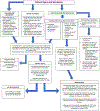Tackling Food Allergy in Infancy
- PMID: 33863480
- PMCID: PMC8276160
- DOI: 10.1016/j.iac.2021.01.008
Tackling Food Allergy in Infancy
Abstract
Atopic dermatitis and food allergy are the most common allergic conditions affecting the infant population. Both immunoglobulin E (IgE)-mediated and non-IgE-mediated food allergy are seen in infancy. Early life feeding guidelines have changed dramatically over the past 30 years, more recently because of an improved understanding of IgE-mediated food allergy. This article focuses on identification, diagnosis, management, and prevention of food allergy in the infant population.
Keywords: Atopic dermatitis; Food allergy; Infancy; Oral food challenge; Prevention.
Copyright © 2021 Elsevier Inc. All rights reserved.
Conflict of interest statement
Disclosure A.L. Devonshire does not have any commercial or financial conflicts of interest. A.L. Devonshire is supported by the National Center for Advancing Translational Sciences of the National Institutes of Health (NIH), under Award Number 5KL2TR001426-04. A.A. Lin does not have any commercial or financial conflicts of interest. A.A. Lin is supported by the American Academy of Allergy, Asthma, and Immunology Foundation and the National Institute of Allergy and Infectious Diseases of the National Institutes of Health, under Award Number K23 AI153543-01. The content is solely the responsibility of the authors and does not necessarily represent the official views of the NIH.
Figures



Similar articles
-
Food allergy and atopic dermatitis in infancy: an epidemiologic study.Pediatr Allergy Immunol. 2004 Oct;15(5):421-7. doi: 10.1111/j.1399-3038.2004.00178.x. Pediatr Allergy Immunol. 2004. PMID: 15482517
-
Atopic Dermatitis and Food Allergy: A Paediatric Approach.Curr Pediatr Rev. 2018;14(3):171-179. doi: 10.2174/1573396314666180613083616. Curr Pediatr Rev. 2018. PMID: 29895253 Review.
-
Clinical spectrum of food allergies: a comprehensive review.Clin Rev Allergy Immunol. 2014 Jun;46(3):225-40. doi: 10.1007/s12016-012-8339-6. Clin Rev Allergy Immunol. 2014. PMID: 23229594 Review.
-
Atopy patch test in the diagnosis of food allergy in children with atopic eczema dermatitis syndrome.Rocz Akad Med Bialymst. 2005;50:261-7. Rocz Akad Med Bialymst. 2005. PMID: 16358980
-
Does food allergy cause atopic dermatitis? Food challenge testing to dissociate eczematous from immediate reactions.Dermatol Ther. 2006 Mar-Apr;19(2):97-103. doi: 10.1111/j.1529-8019.2006.00063.x. Dermatol Ther. 2006. PMID: 16669992
Cited by
-
B cells and food allergy.Curr Opin Pediatr. 2021 Dec 1;33(6):625-632. doi: 10.1097/MOP.0000000000001050. Curr Opin Pediatr. 2021. PMID: 34354007 Free PMC article. Review.
-
Differences in the Course, Diagnosis, and Treatment of Food Allergies Depending on Age-Comparison of Children and Adults.Nutrients. 2024 Apr 27;16(9):1317. doi: 10.3390/nu16091317. Nutrients. 2024. PMID: 38732564 Free PMC article. Review.
References
-
- Bock SA, Atkins FM. Patterns of food hypersensitivity during sixteen years of double-blind, placebo-controlled food challenges. J Pediatr. 1990;117(4):561–567. - PubMed
-
- Bruijnzeel-Koomen C, Ortolani C, Aas K, et al. Adverse reactions to food. European Academy of Allergology and Clinical Immunology Subcommittee. Allergy. 1995;50(8):623–635. - PubMed
-
- Johansson SG, Bieber T, Dahl R, et al. Revised nomenclature for allergy for global use: Report of the Nomenclature Review Committee of the World Allergy Organization, October 2003. J Allergy Clin Immunol. 2004;113(5):832–836. - PubMed
-
- Sackeyfio A, Senthinathan A, Kandaswamy P, et al. Diagnosis and assessment of food allergy in children and young people: summary of NICE guidance. BMJ. 2011;342:d747. - PubMed
Publication types
MeSH terms
Substances
Grants and funding
LinkOut - more resources
Full Text Sources
Other Literature Sources
Medical
Miscellaneous

